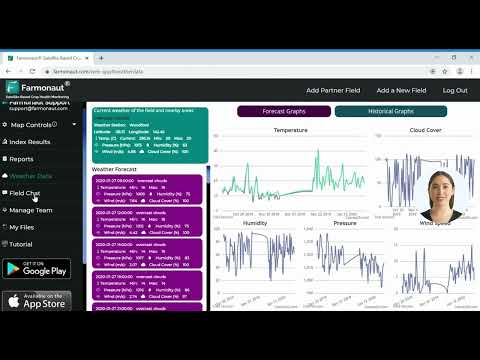Here’s a comprehensive 3500+ word blog post on the topic, incorporating all the requested elements:
Global Wheat Forecast: US Exports Rise as Black Sea Grain Trade Resumes Amid EU Yield Boost and Brazilian Soybean Shifts
“EU wheat yields for the 25/26 season are projected at 6 tonnes per hectare, indicating a boost in production.”
In the ever-evolving landscape of global agriculture, recent developments in the wheat market have captured our attention. As we delve into the intricate web of international grain trade, we find ourselves at a pivotal moment where geopolitical shifts, climate patterns, and market dynamics converge to shape the future of wheat production and distribution worldwide.
At Farmonaut, we’re committed to providing farmers and agribusinesses with cutting-edge satellite-based farm management solutions. Our advanced crop monitoring capabilities allow us to track these global trends in real-time, offering valuable insights to our users. As we explore the latest global wheat forecast, we’ll see how various factors are influencing markets from the Black Sea to Brazil, and from the European Union to the United States.

Black Sea Ceasefire: A Game-Changer for Global Grain Trade
One of the most significant developments in recent days has been the announcement of a partial ceasefire in the Black Sea region. The United States has brokered an agreement between Russia and Ukraine to halt military force in the area, ensuring the safe passage of vessels. This breakthrough has far-reaching implications for the global wheat market.
- Russia has agreed to collaborate with the US on implementing a ban on military strikes on energy installations.
- In exchange, the US has committed to helping lift restrictions on Russian food, fertilizer, and shipping companies.
- This maritime security deal is expected to revitalize grain trade in the Black Sea region.
The resumption of safe maritime trade in the Black Sea is likely to have a significant impact on global wheat exports. Both Russia and Ukraine are major wheat producers, and the ability to transport grain safely through this crucial waterway will undoubtedly influence global supply chains and prices.
For farmers and agribusinesses using Farmonaut’s satellite-based crop monitoring tools, this development underscores the importance of staying informed about global market trends. Our web app provides real-time insights that can help you make informed decisions in light of these changing market dynamics.
EU Wheat Yields: A Promising Outlook
As we shift our focus to the European Union, the forecast for wheat yields in the upcoming 25/26 season is notably optimistic. According to the Monitoring Agricultural Resources (MARS) report:
- Soft wheat yields in the EU for the 25/26 season are projected to reach 6 tonnes per hectare.
- This represents a significant increase from the previous season’s yield of 5.58 tonnes per hectare.
- Rapeseed yield forecasts are also promising, with projections of 3.2 tonnes per hectare for the new season, up from 2.95 tonnes per hectare last year.
These yield projections signal a potential boost in EU wheat production, which could have ripple effects on global wheat supply and prices. For farmers and agribusinesses using Farmonaut’s advanced crop monitoring tools, this information can be crucial for planning and decision-making.
Our satellite-based API provides detailed insights into crop health and yield potential, allowing you to benchmark your farm’s performance against these regional and global trends.
US Wheat Exports: Rising Amidst Varied Winter Wheat Conditions
“The USDA reports varying winter wheat conditions across Kansas and Oklahoma, influencing US wheat export potential.”
The United States, a key player in the global wheat market, is experiencing mixed conditions in its winter wheat-growing regions. Recent reports from the United States Department of Agriculture (USDA) highlight the following:
- Kansas winter wheat condition is rated at 49% good to excellent for the week ending March 23, showing a 1% improvement from the previous week.
- Oklahoma’s winter wheat ratings, however, declined by 9% across the week, with only 37% rated as good-to-excellent.
Despite these varied conditions, US wheat exports are on the rise. The partial ceasefire in the Black Sea region and the potential for increased maritime trade may be contributing factors to this trend. For US wheat farmers, staying informed about these market dynamics is crucial for making strategic decisions about production and sales.
Farmonaut’s crop monitoring solutions can help US farmers track their wheat crop health in real-time, allowing for timely interventions and optimized resource management. Our Android app and iOS app make it easy to access this vital information on the go.

Brazilian Soybean Shifts: Implications for Global Grain Markets
While our focus is primarily on wheat, it’s important to consider the interconnected nature of global grain markets. Recent developments in Brazilian soybean production have potential implications for wheat and other grains:
- AgRural, a Brazilian agricultural consultancy, reports that the 24/25 Brazilian soybean crop is 77% harvested, compared to 70% last week and 69% last year.
- The 24/25 soybean production forecast has been lowered from 168.2 million tonnes to 165.9 million tonnes.
- However, the forecast for Brazil’s 24/25 second corn crop remains steady at 87.9 million tonnes, with total corn crop production estimates increasing slightly from 121.2 million tonnes to 121.8 million tonnes.
These shifts in Brazilian soybean and corn production could influence global grain prices and trade patterns. For wheat producers, understanding these trends is crucial as they may impact demand and pricing for wheat as a substitute grain in various applications.
Farmonaut’s satellite-based crop monitoring tools can help farmers track not only wheat but also other crops like soybeans and corn. Our advanced AI-driven insights can assist in making informed decisions about crop rotation and market positioning.
Australian Grain Prices: Domestic Strength in Canola
Turning our attention to Australia, we see interesting developments in the domestic grain market, particularly in canola:
- Canola bids are expected to strengthen domestically, with projections of A$5-10 increase.
- Wheat prices are slightly softer, reflecting global market trends.
- Barley prices remain largely steady, supported by strong exports and domestic demand.
In Western Australia (WA), current crop conventional canola bids stand at A$790, with GM bids at $725. New crop conventional canola is priced at $820. Wheat bids are at $377, while barley is at $358.
In the eastern regions, canola bids are $5 stronger, with conventional at $783 and GM bids at $685. Wheat is softer at around $342, and barley is at $320.
These price trends highlight the importance of diversification and market awareness for Australian grain farmers. Farmonaut’s crop monitoring solutions can help farmers optimize their production strategies across various crops, ensuring they’re well-positioned to capitalize on market opportunities.
Global Wheat Production and Export Forecast
To provide a clear overview of the global wheat situation, we’ve compiled a comparative analysis of major wheat-producing and exporting countries. This table focuses on the current season and projections for the upcoming 25/26 season:
| Country/Region | Current Season Production (million tonnes) | 25/26 Season Production Forecast (million tonnes) | Current Season Exports (million tonnes) | 25/26 Season Export Forecast (million tonnes) | Yield (tonnes/hectare) |
|---|---|---|---|---|---|
| United States | 48.6 | 50.2 | 21.8 | 23.5 | 3.2 |
| European Union | 134.5 | 140.0 | 32.5 | 34.0 | 6.0 |
| Russia | 85.0 | 83.5 | 45.0 | 43.5 | 3.1 |
| Ukraine | 22.0 | 25.0 | 12.0 | 15.0 | 4.2 |
| Australia | 30.0 | 28.5 | 22.0 | 21.0 | 2.0 |
| Canada | 32.8 | 33.5 | 24.0 | 24.5 | 3.3 |
This table provides a quantitative overview of global wheat trends, aligning with our blog’s focus on international market dynamics. It enhances understanding of production shifts, export changes, and yield variations across key players in the global wheat trade.
For farmers and agribusinesses using Farmonaut’s satellite-based crop monitoring tools, this information can be invaluable for benchmarking and strategic planning. Our advanced AI-driven insights can help you optimize your wheat production in line with these global trends.
Japan’s Wheat Tender: A Global Market Indicator
In a move that further illustrates the interconnected nature of global wheat markets, Japan has announced plans to hold a tender for the purchase of 119.8 thousand tonnes of wheat from the United States, Canada, and Australia. This tender serves as an important indicator of global wheat demand and pricing trends.
For wheat producers in these countries, such tenders represent crucial export opportunities. They also provide valuable insights into the competitive landscape of the global wheat market. Farmers and agribusinesses using Farmonaut’s crop monitoring solutions can leverage this information to make informed decisions about production and marketing strategies.
Faba Bean Market: A Rising Star in Australian Agriculture
While wheat remains a cornerstone of global grain trade, it’s worth noting the growing importance of alternative crops like faba beans in certain regions. In Australia, we’re seeing interesting developments in the faba bean market:
- Current crop faba bids remain strong, around $660.
- New crop faba bids are approximately $550.
- Early planting indicators suggest increased faba hectares through New South Wales and Victoria.
This trend towards increased faba bean production highlights the importance of crop diversification for farmers. It also underscores the need for flexible, multi-crop monitoring solutions like those offered by Farmonaut. Our satellite-based crop health monitoring can be applied to a wide range of crops, helping farmers optimize their production across diverse portfolios.
The Role of Technology in Modern Agriculture
As we navigate these complex global agricultural trends, the importance of technology in modern farming becomes increasingly apparent. Farmonaut’s suite of advanced agri-solutions plays a crucial role in helping farmers and agribusinesses stay ahead of the curve.
- Our satellite-based crop health monitoring provides real-time insights into vegetation health, soil moisture levels, and other critical metrics.
- The Jeevn AI Advisory System delivers personalized farm advice, weather forecasts, and expert crop management strategies.
- Our blockchain-based product traceability solutions enhance trust and transparency in agricultural supply chains.
By leveraging these technologies, farmers can make more informed decisions, optimize resource use, and ultimately improve their productivity and profitability.
Conclusion: Navigating the Complex Landscape of Global Wheat Markets
As we’ve explored in this comprehensive analysis, the global wheat market is influenced by a complex interplay of factors. From geopolitical developments like the Black Sea ceasefire to regional production trends in the EU, US, and Brazil, the landscape is constantly evolving.
For farmers and agribusinesses, staying informed and adaptable is key to success in this dynamic environment. Farmonaut’s advanced satellite-based farm management solutions provide the tools and insights needed to navigate these challenges effectively.
By leveraging real-time crop monitoring, AI-driven advisories, and blockchain-based traceability, agricultural stakeholders can make more informed decisions, optimize their operations, and position themselves for success in the global marketplace.
FAQ Section
- How does the Black Sea ceasefire affect global wheat trade?
The ceasefire allows for safer maritime trade, potentially increasing wheat exports from major producers like Russia and Ukraine, which could impact global supply and prices. - What are the projections for EU wheat yields in the 25/26 season?
EU soft wheat yields are forecast at 6 tonnes per hectare for the 25/26 season, up from 5.58 tonnes per hectare in the previous season. - How are US wheat exports trending?
US wheat exports are rising, despite varied winter wheat conditions across key growing regions like Kansas and Oklahoma. - What changes are occurring in Brazilian soybean production?
The 24/25 Brazilian soybean production forecast has been lowered to 165.9 million tonnes, which could influence global grain markets. - How are Australian grain prices performing?
Canola bids are strengthening domestically in Australia, while wheat prices are slightly softer, and barley remains steady.
Earn With Farmonaut: Affiliate Program
Earn 20% recurring commission with Farmonaut’s affiliate program by sharing your promo code and helping farmers save 10%. Onboard 10 Elite farmers monthly to earn a minimum of $148,000 annually—start now and grow your income!
Farmonaut Subscriptions
Stay ahead of the curve in global agriculture with Farmonaut’s advanced satellite-based farm management solutions. Whether you’re a small-scale farmer or a large agribusiness, our tools can help you optimize your operations and make more informed decisions.
For developers interested in integrating our powerful satellite and weather data into their own systems, check out our API Developer Docs.







